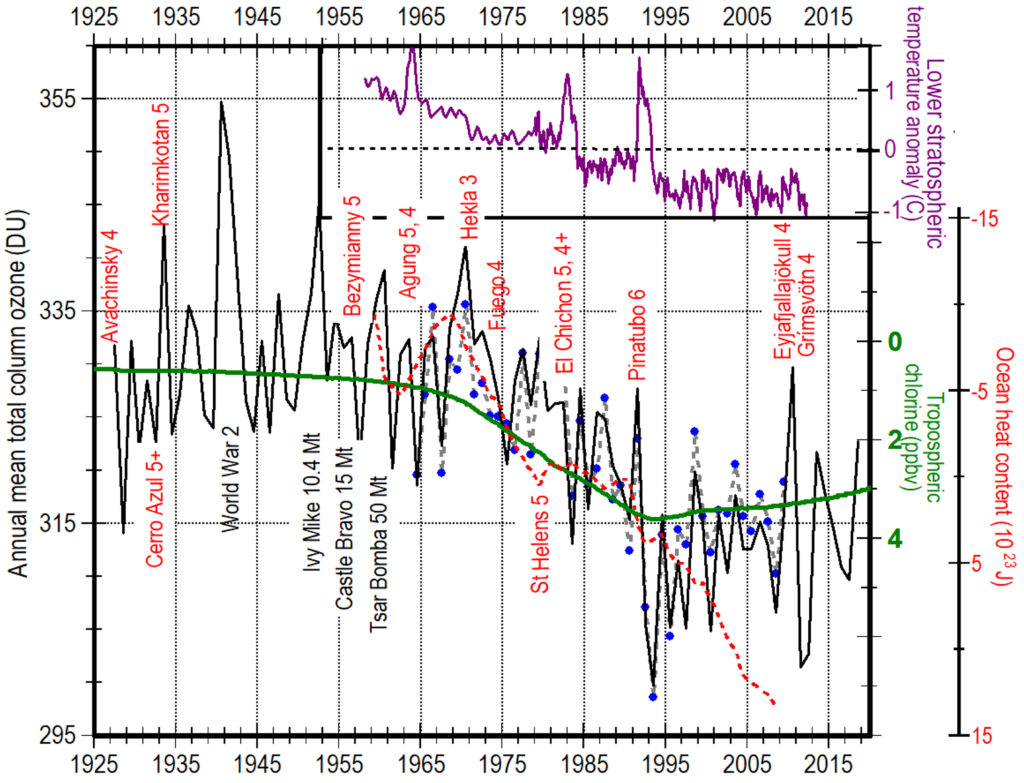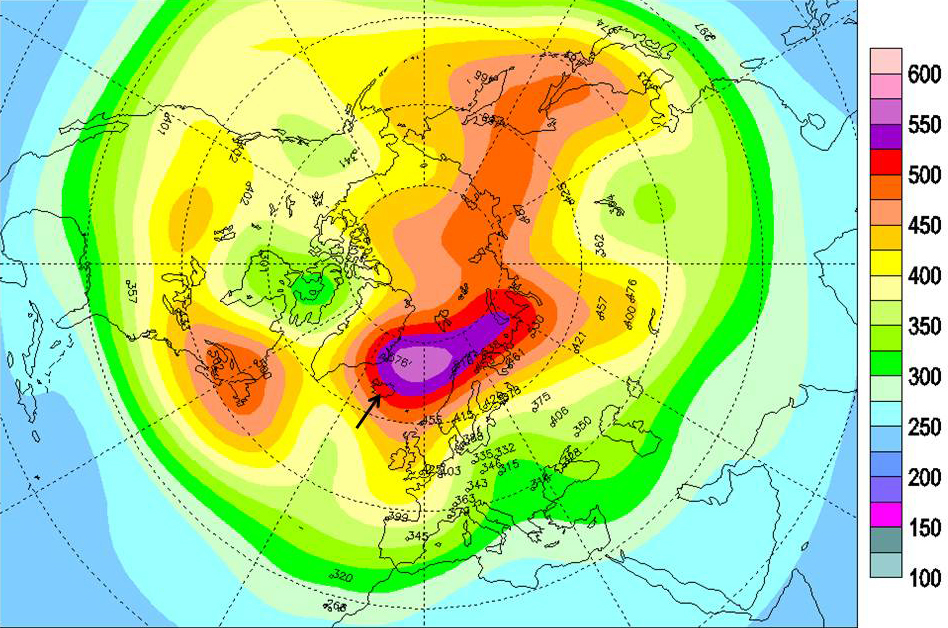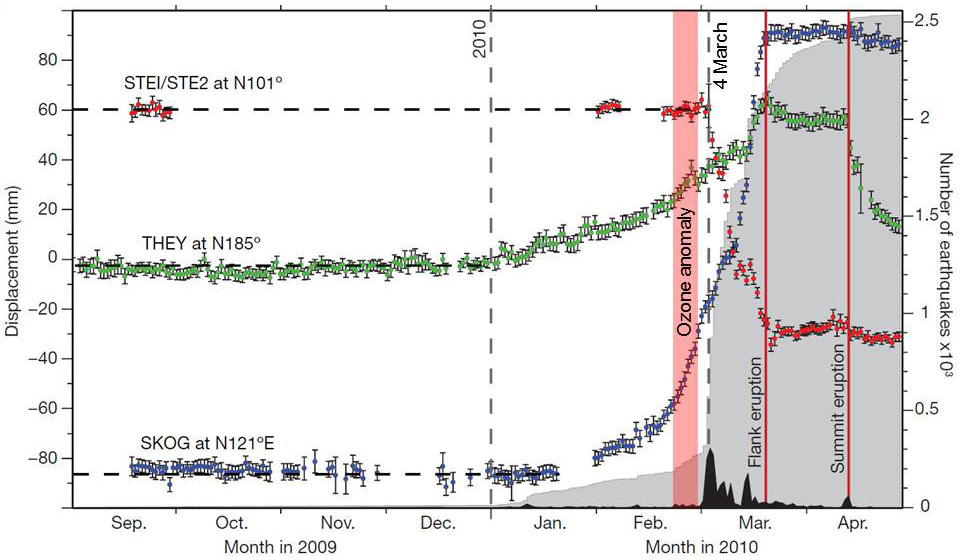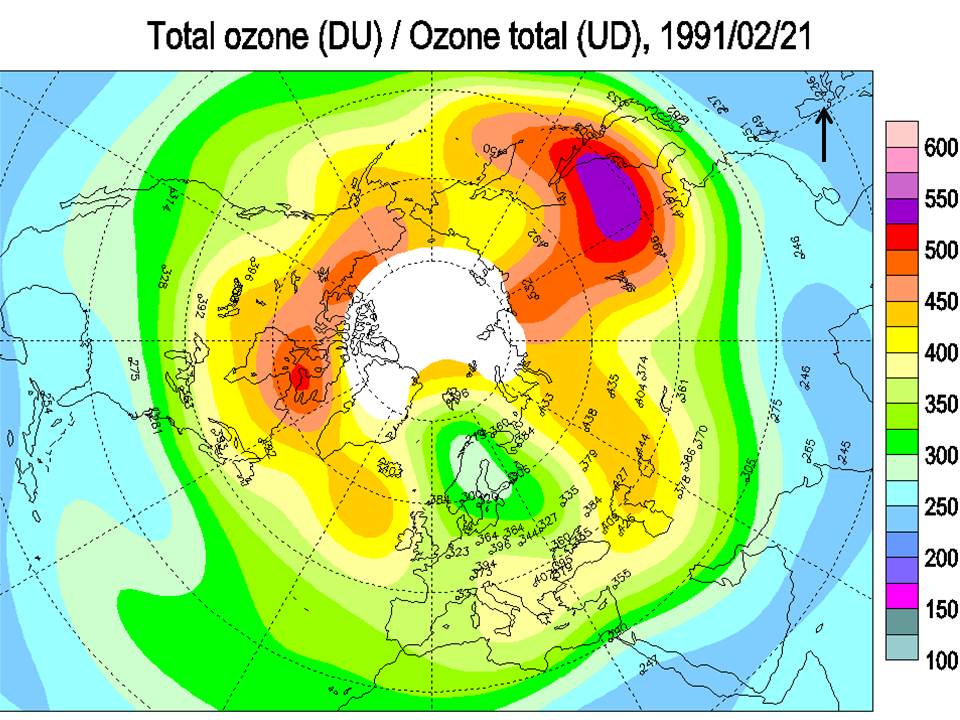Increases in Total Column Ozone Before Volcanic Eruptions

Annual total column ozone observed at Arosa, Switzerland, increased 12 DU (4%) in 1991, the year Pinatubo and Cerro Hudson erupted, but decreased 28 DU (8%) by 1993. Similarly ozone increased 14 DU (4%) in 2010 when Eyjafjallajökull erupted but decreased 28 DU (8%) in 2011. Other volcanic eruptions are also contemporaneous with a modest increase in ozone followed the next year by a decrease of at least twice as much.

CLICK TO ANIMATE.

The ozone increase in 2010 occurred primarily between February 19 and February 26, ~4 weeks before the first effusive flank eruption of basalt from March 20 to April 12 and ~7 weeks before the main explosive eruption of trachyandesite on April 14. Total ozone northeast of Iceland increased to more than 550 DU on February 19 over a background of ~325 DU, an increase of ~70% (Environment Canada, 2013). The deviation of total ozone over the period from February 21 to February 28 increased 45% compared to mean levels from 1978 through 1988 (Environment Canada, 2013). The sudden onset of these emissions is shown clearly in an animation of daily ozone maps from December 1, 2009 to April 30, 2010 (Click on map).
At Eyjafjallajökull, seismic activity and deformation began in December 2009, “explained by a single horizontal sill inflating at a depth of 4.0 to 5.9 km under the south-eastern flank of the volcano” (Sigmundsson et al., 2010). Deformation increased exponentially in February, suggesting a major change in pressure conditions within the system by March 4. Thus a substantial release of gas from the top of the magma body is highly likely to have occurred in late February as the roof of the intrusion fractured to the surface.
It is conceivable that oxygen fugacity in magma is sufficient to concentrate oxygen gas in the very high temperature (high energy) environment at the top of a magma body where ozone could be formed and then released when fractures first propagate to the surface. But oxygen and ozone are not likely volcanic gases because magma typically has a reduced oxidation state.
Sulfur dioxide (SO2) is a primary gas emitted from high-temperature fumaroles. SO2 absorbs ultraviolet solar radiation strongly at the same wavelengths as ozone and is known to affect ozone measurements in urban areas such as Uccle, just outside of Brussels, Belgium (De Muer and De Backer, 1992). SO2 is colorless so that its release from high-temperature fumaroles in the vicinity of the effusive eruption that began on 20 March would have gone unnoticed if substantial water vapor was not included. There were no instruments in the vicinity to detect either SO2 or ozone. But satellite data are normally sufficient to distinguish ozone from SO2. Local farmers did note unusual melting of snow near high temperature fumaroles “months” before the eruption of Hekla in south Iceland on May 5, 1970 (Thorarinsson and Sigvaldason, 1972) (Thorarinsson, 1970).
Another possibility is that high-temperature (high-energy) gases from basaltic magma (1300 to 1400oC) (Lee et al., 2009) may interact in some way with water released from the magma, with ground water, or even with atmospheric water vapor to split oxygen atoms and form ozone. Magmatic high-temperature gases might also interact with volatile organic compounds or nitrogen compounds or gases to form ozone catalytically.
Yet another possibility is that the ozone was generated by rock fracture as the gases at the top of the magma broke to the surface. Crushing and grinding small samples of igneous and metamorphic rocks at atmospheric pressure in the laboratory generated up to 10 ppm ozone apparently “formed by exoelectrons emitted by high electric fields, resulting from charge separation during fracture” (Baragiola et al., 2011).

Mt. Pinatubo in the Philippines showed signs of reawakening with a group of felt earthquakes on March 15, 1991, the first steam explosions on April 2, first eruption on June 12, and the main eruption on June 15. Ozone anomalies >550 DU, a 40% increase, occurred from February 20 to 22, 1991 at 44 to 58oN, 115 to 140oE. The winter-time Brewer-Dobson circulation is thought to move ozone and related gases from the latitude of Pinatubo (15.1oN, 120.4oE) up into the stratosphere, northward, and then downward north of 40oN (Cordero et al., 2003). The sudden onset of these emissions is shown clearly in an animation of daily ozone maps for the northern hemisphere from January 1, 1991 to May 10, 1991 (Click on map). The upward motion of the Brewer-Dobson circulation in the tropics is thought to move normally at a rate of 20 to 30 meters per day (Cordero et al., 2003), but the heat of volcanic gases might increase that rate substantially. There is a “fast” component of the Brewer-Dobson circulation that can move air within days from the tropics to the subtropics (Birner and Bönisch, 2011).
Similar anomalies occurred over Hudson Bay, Canada, at 60 to 70oN from February 26 to March 3, 1991, with no obvious spatial relationship to any volcano. These large ozone anomalies are most common during the winter, north of 60oN, and they may be related to sudden stratospheric warming in specific regions (Plumb, 2002) (Waugh and Polvani, 2010).
The contemporaneity of some of these large ozone anomalies with pre-eruption intrusion could be coincidence. Considerable work is needed to prove any causal relationship. Ozone emission prior to volcanic eruptions would provide a good explanation for why the Great Oxidation Event 2.45 to 2.32 billion years before present was contemporaneous with the first known prodigious sub-aerial emissions of magma (Kump and Barley, 2007) (Campbell and Allen, 2008) (Kump et al., 2005).